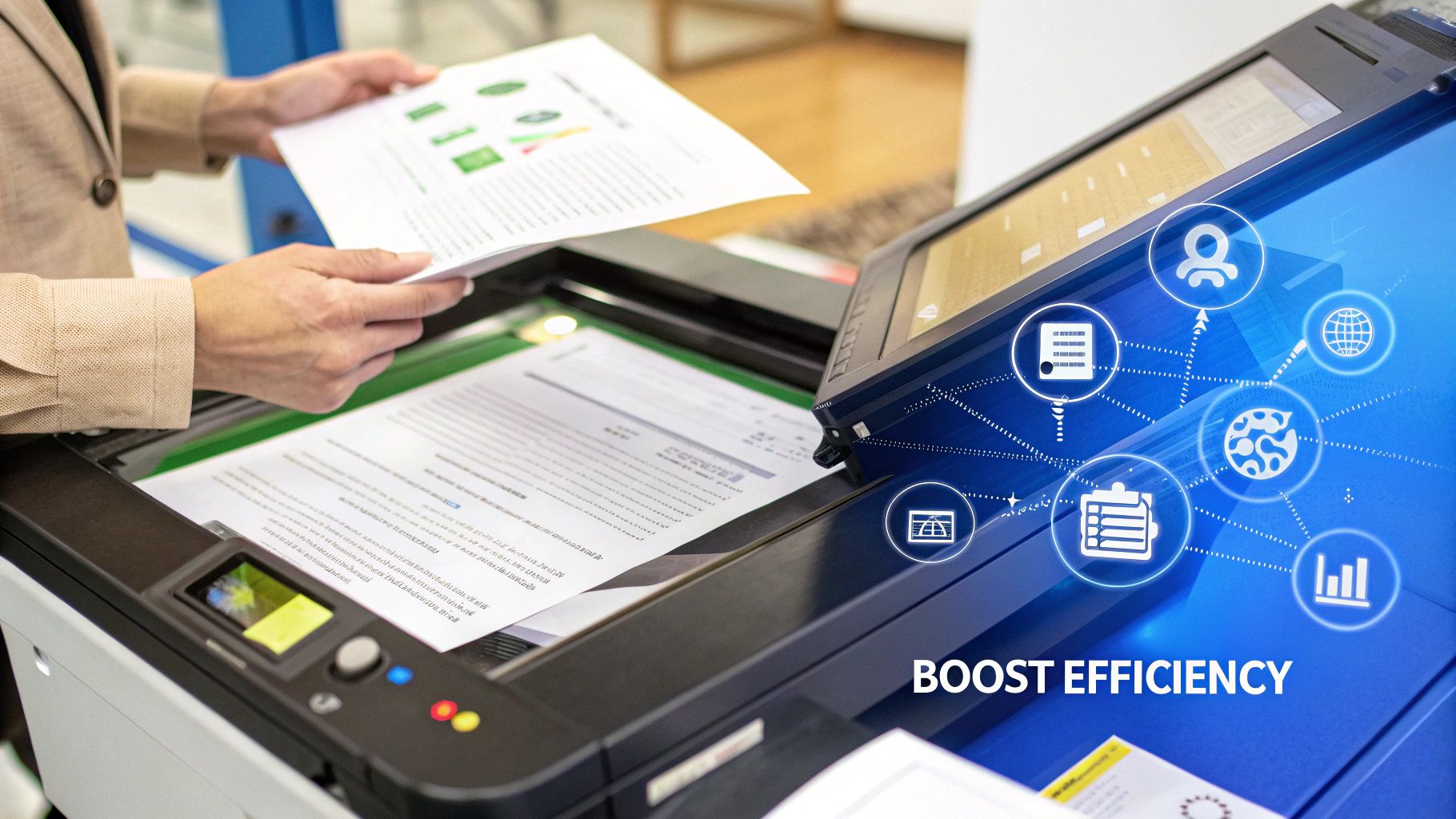The Real-World Impact of Document Workflow Automation

Document workflow automation is changing how businesses operate. It transforms static documents into dynamic components of business processes. Instead of slow, manual processes, automated systems create a seamless flow of information. This isn’t just about digitizing existing processes. Document workflow automation reimagines how information moves between teams, systems, and customers.
Streamlining Operations for Enhanced Efficiency
Consider the traditional employee onboarding process. HR departments often deal with large amounts of paperwork, like applications, tax forms, and policy agreements. This manual process is slow, prone to errors, and can create a negative first impression for new hires. Document workflow automation allows these documents to be collected, processed, and routed electronically. This significantly reduces processing time and improves accuracy.
Automated workflows can also integrate with other business systems, such as payroll and benefits platforms. This integration removes manual data entry, reducing errors and freeing HR staff for more strategic work. Companies can onboard new employees faster, improve compliance, and provide a more positive onboarding experience.
Measurable Impact Across Industries
The benefits of document workflow automation span many industries. In healthcare, it can streamline patient record management and claims processing. In finance, it automates loan applications and invoice processing. For legal teams, it facilitates contract management and compliance reporting. These examples highlight the versatility of document workflow automation in solving industry-specific challenges.
The document workflow automation market is growing rapidly. It’s projected to reach USD 37.45 Billion by 2030. The need for increased efficiency in sectors like healthcare, finance, and legal fuels this growth. You can learn more about this growth at Mordor Intelligence. This demonstrates the increasing value placed on automation in business.
From Digitization to True Transformation
Document workflow automation is more than just digitization. Digitizing documents creates electronic versions, but it doesn’t always fix inefficient processes. True automation involves rethinking and optimizing the entire workflow. This means analyzing existing processes, finding bottlenecks, and implementing automated solutions to improve efficiency and accuracy. Ultimately, document workflow automation helps businesses save money, improve customer satisfaction, and gain a competitive edge.
Building the Business Case That Gets Approved

Securing executive buy-in for document workflow automation hinges on a robust business case. This case needs to center on a clear return on investment (ROI), demonstrating the direct impact of automation on the bottom line. In essence, it’s about communicating the value proposition in terms that resonate with leadership.
Quantifying the Benefits of Automation
A compelling business case begins with quantifying the costs of existing manual processes. This involves calculating the time employees spend on document-related tasks.
For example, how many hours are spent on data entry, routing documents, and tracking approvals? This analysis establishes a baseline for measuring the potential impact of automation.
Additionally, consider the costs associated with errors. Manual processes are prone to human error, leading to rework, delays, and even compliance penalties. These errors represent a significant, often overlooked, cost that automation can drastically reduce. Minimizing errors boosts accuracy and efficiency.
Beyond these tangible costs, consider the less quantifiable benefits. These include improved customer satisfaction through faster processing times and higher employee morale by removing tedious tasks.
Happier employees are more productive and engaged, leading to better business outcomes. These “soft” benefits, while harder to measure, contribute significantly to the overall value of automation. You might be interested in: How to master document collection across various industries.
Addressing Common Objections
Proactively address potential objections. Concerns about security, implementation timelines, and costs are typical. Prepare data-driven responses to showcase the security measures within automated systems, provide realistic implementation timelines, and outline the anticipated payback period. This proactive approach builds confidence and addresses leadership reservations.
By 2025, 80% of organizations are projected to adopt intelligent automation tools to streamline document-centric processes. These tools reduce errors in repetitive tasks like data entry, which can account for almost 30% of operational costs in sectors like banking.
Workflow automation also delivers measurable ROI: companies report annual savings from $10,000 to millions of dollars, depending on the scale of implementation. Marketing teams using automated document workflows see a 451% increase in qualified leads. More detailed statistics can be found here: Workflow Automation Statistics and Trends. This underscores the widespread adoption and proven success of document workflow automation.
The following table summarizes the potential ROI of document workflow automation:
Document Workflow Automation ROI Metrics
| Benefit Category | Average Improvement | Implementation Timeframe |
|---|---|---|
| Reduced Data Entry Errors | Up to 30% | Short-term |
| Improved Processing Time | Varies depending on process | Short to medium-term |
| Increased Employee Productivity | Varies depending on tasks | Medium-term |
| Increased Qualified Leads (Marketing) | Up to 451% | Medium to long-term |
| Cost Savings | $10,000 to Millions annually | Long-term |
This table highlights the key benefits and the timeframe in which organizations typically realize them. The potential for cost savings and improved productivity makes a strong case for automation.
Presenting a Clear ROI
Present the expected ROI. Detail the implementation costs, ongoing maintenance expenses, and projected cost savings. This provides leadership with a transparent view of the financial benefits. It demonstrates that the investment will lead to long-term cost reductions and increased efficiency. A well-structured business case, backed by data and addressing potential concerns, elevates an “interesting idea” to an “approved project.”
High-Value Document Workflows Ready for Automation Now
Stop wasting time and resources on manual document processes. This section explores document workflows that offer a quick return on investment (ROI) when automated. We’ll examine specific, high-value automation opportunities across different departments, from finance and HR to operations. This will help you identify the best automation candidates within your own organization.
Identifying Prime Automation Candidates
Knowing which workflows will benefit most from automation is key. Look for signs like high-volume, repetitive tasks, multiple handoffs, frequent errors, or strict compliance requirements. These indicate that automation can drastically improve efficiency and accuracy. Invoice processing in finance, for example, often involves these very pain points. Manual data entry, routing invoices for approvals, and reconciliation are time-consuming and prone to errors.
Document workflow automation can transform these processes. Superdocu, for instance, offers pre-built templates and automated reminders to speed up document collection and review. This removes manual data entry and reduces errors. Employee onboarding in HR can also be improved through automation. Automated workflows can collect employee information, manage policy acknowledgments, and integrate with payroll systems, creating a smoother process for HR and new hires.
Automating Across Departments: Examples and Outcomes
Several key workflows are ready for automation. In finance, invoice processing and expense approvals are two common examples. Automating these workflows can cut processing time by up to 80%, giving finance teams more time for strategic work. In HR, automating onboarding and policy acknowledgments boosts efficiency and ensures compliance, leading to faster time-to-productivity for new hires. Automating quality documentation and compliance reporting in operations increases accuracy and reduces errors, creating a more reliable system for managing crucial documents.
The data chart below visualizes the average processing time reduction achieved through document workflow automation.
As the chart shows, automating these key workflows significantly reduces processing time, leading to improved efficiency and productivity.
Let’s take a closer look at the potential impact of automation based on some key statistics.
To illustrate this further, let’s consider a comparison table.
Comparison of Manual vs. Automated Document Workflows
| Business Process | Manual Processing Time | Automated Processing Time | Error Rate Reduction | Cost Savings |
|---|---|---|---|---|
| Invoice Processing | 5 days | 1 day | 70% | 60% |
| Expense Approvals | 3 days | 1 day | 60% | 50% |
| Onboarding | 2 weeks | 1 week | 50% | 40% |
| Policy Acknowledgements | 1 week | 2 days | 40% | 30% |
| Quality Documentation | 2 days | 1 day | 30% | 20% |
| Compliance Reporting | 1 week | 3 days | 20% | 15% |
This table highlights the substantial benefits of automation across various business processes. The reduced processing times, error rate reductions, and cost savings demonstrate the compelling case for automation.
Despite these clear benefits, surprisingly few businesses have fully automated their workflows. Only 4% of businesses globally have done so. Research suggests that 50% of work activities, including document routing and data extraction, are automatable, offering huge productivity gains. Automated email workflows, for example, generate twice as many leads and 58% more conversions than manual processes. Yet, 62% of companies still struggle with inefficiencies like slow invoice processing, highlighting the untapped potential of automation. Find more statistics here: Document Workflow Automation Statistics. This data emphasizes the significant opportunities for businesses to improve their operations through document workflow automation. By using automation solutions like Superdocu, organizations can substantially enhance their efficiency, accuracy, and ultimately, their bottom line.
The Technology Stack Powering Modern Document Automation

Modern document workflow automation goes beyond simple scanning and storage. It uses a collection of interconnected technologies to transform static documents into dynamic data, boosting efficiency and informing better decisions. Let’s explore the core components of these powerful solutions.
Intelligent Document Processing (IDP)
At the heart of it all is Intelligent Document Processing (IDP). IDP uses artificial intelligence (AI) and machine learning (ML) to extract valuable information from unstructured documents. Think of it as a digital assistant that reads and understands documents like contracts, invoices, and forms.
IDP automatically identifies key data points, categorizes documents, and even flags potential errors. This significantly reduces manual data entry and improves accuracy. Tools like Superdocu integrate IDP to automate document collection and validation, making workflows more efficient.
Machine Learning (ML) for Continuous Improvement
Machine learning algorithms are crucial for optimizing document workflows over time. These algorithms learn from data patterns, allowing systems to identify bottlenecks and automatically improve routing, data extraction, and decision-making.
For example, an ML-powered system can learn which documents require specific approvals. It then automatically routes them to the right people, speeding up the entire process. This adaptive learning is key to maximizing the long-term benefits of automation.
Natural Language Processing (NLP) for Enhanced Understanding
Natural Language Processing (NLP) enhances document understanding. NLP allows systems to grasp the context, sentiment, and nuances within the text. This means document automation solutions can not only extract data, but also interpret its meaning.
For instance, NLP can analyze contracts, identify potential risks, and even draft summaries or responses. This significantly expands what’s possible with automation.
Integration Capabilities for Seamless Connectivity
Effective document workflow automation requires smooth integration with existing business systems. Modern platforms connect with CRM software, ERP systems, and other applications. This integration ensures information flows smoothly across the entire technology landscape.
It also eliminates data silos and maximizes the value of automated workflows. Superdocu integrates with tools like Zapier and DocuSign, extending its automation capabilities to thousands of other applications and incorporating e-signatures into document workflows.
APIs and Low-Code/No-Code Platforms
Application Programming Interfaces (APIs) are essential for connecting different parts of the document automation system. They allow different software components to communicate and exchange data, enabling seamless integration and customization.
Low-code/no-code platforms empower business users to build and modify workflows without needing extensive coding knowledge. This increases agility and reduces reliance on IT departments. These platforms often provide drag-and-drop interfaces and pre-built templates, making document automation accessible to more users and enabling faster implementation. Organizations can use these technologies to build customized document automation solutions for specific business needs.
From Legacy Systems to Automated Workflows: A Roadmap
Moving from manual document processes to automated workflows isn’t a quick fix. It requires careful planning. This roadmap provides practical steps for implementing document workflow automation, based on successful transitions across various industries. We’ll cover assessing your current systems, prioritizing workflows, and building a phased approach for effective automation.
Assessing Your Current Document Landscape
The first step is understanding your current document processes. Identify workflows heavily reliant on manual tasks. Ask yourself which departments handle large volumes of paperwork. Where are the bottlenecks slowing things down? This initial assessment identifies areas ripe for automation. Consider the types of documents used, their flow within the organization, and the systems currently in place. Understanding your current state allows for effective planning of the transition to automated workflows.
Identifying Priority Workflows
Not all workflows are equally important. Some offer a higher return on investment (ROI) when automated. Focus on processes with high volume, repetitive tasks, multiple handoffs, and frequent errors. These are ideal candidates for automation. For example, invoice processing in finance or onboarding in HR often involves these pain points. Automating these workflows can significantly reduce time and costs. Prioritizing workflows ensures you target the areas with the greatest impact. Learn more in this article about how to master document automation for seamless workflows.
Building a Phased Approach
Implementation should be phased. Start with a pilot project focusing on a specific workflow. This lets you test and refine your approach before organization-wide scaling. For example, begin automating invoice processing in a single department. Track the results and apply those lessons before expanding to other departments. A phased approach minimizes disruption and allows for adjustments.
Overcoming Implementation Hurdles
Implementation challenges are unavoidable. Technology integration issues can arise when connecting new automation tools with legacy systems. Employee resistance is another common hurdle. Address these challenges with clear communication and training. Explain automation’s benefits to employees and provide support during the transition. A smooth transition relies on addressing both technical and human factors.
Change Management and Training
Effective change management is crucial for successful automation. Clearly communicate upcoming changes and their effects on employees. Provide comprehensive training on new systems and processes. This builds confidence and encourages adoption. Change management ensures a smooth transition and maximizes automation’s benefits.
Governance and Compliance
Maintaining governance and compliance within automated workflows is critical. Establish clear guidelines and procedures for document management, access control, and data security. This ensures compliance with regulatory requirements. Strong governance frameworks mitigate risks and ensure long-term success.
Case Studies and ROI
Real-world examples demonstrate the power of document workflow automation. Case studies show how other organizations have successfully implemented automation, the challenges they faced, and their results. Analyzing these cases offers valuable insights and best practices. Quantifying the ROI of automation strengthens its justification. Tracking key metrics like processing time, error rates, and cost savings demonstrates automation’s value. Showcasing tangible benefits builds a stronger case for continued investment in document workflow automation.
Beyond Basic Automation: What’s Next in Document Workflows
Implementing basic document workflow automation is a significant first step for any business. But the real advantages come from exploring more advanced capabilities. This section looks at emerging technologies shaping the future of document workflows and pushing the boundaries of what’s possible, moving beyond simple automation to proactive, intelligent systems.
Predictive Analytics: Anticipating Bottlenecks
Imagine a document workflow that anticipates problems before they happen. That’s the power of predictive analytics. By analyzing past workflow data, these systems can identify patterns and predict potential bottlenecks. This lets businesses proactively address issues, optimize how they use resources, and ensure smooth document flow.
For example, if a system predicts a delay in invoice approvals, it could automatically notify the appropriate people and suggest alternative approval routes. This shift from reactive to proactive management is a major benefit of advanced document workflow automation, helping organizations operate more efficiently and avoid costly delays.
Blockchain Integration: Enhancing Security and Trust
Blockchain technology is transforming document verification and compliance. It creates unchangeable audit trails, ensuring document integrity and authenticity. This is particularly valuable in industries with strict regulations.
For example, a blockchain-based system can track a contract’s entire lifecycle–from creation and signing to execution–guaranteeing its validity and preventing tampering. This increases trust and transparency in document workflows. Plus, blockchain simplifies compliance audits by providing readily available, verifiable records of all document transactions. This significantly reduces the time and effort needed for compliance reporting.
Voice Interfaces and NLP: Streamlining Interactions
Voice interfaces and Natural Language Processing (NLP) are changing how we interact with technology. Within document workflows, these technologies allow users to manage documents through voice commands or natural language queries.
For instance, an employee could use a voice assistant to request a document, check its status, or begin an approval process. NLP enables systems to understand the meaning behind these requests, ensuring accurate and efficient processing. This makes document management simpler and more accessible. You can also read: How to integrate document automation solutions into your workflows.
Real-World Applications and Future Trends
Organizations are already using advanced document workflow automation. Some companies utilize AI-powered systems to automatically analyze contracts, pulling out key information and identifying potential risks. Others are using blockchain-based solutions to securely manage sensitive documents. These real-world examples show the potential of these emerging technologies.
As AI and other technologies continue to develop, we can expect even more advanced document workflow solutions. These solutions will not only automate current processes but also create new opportunities for collaboration, analysis, and decision-making.
Ready to experience the future of document workflows? Superdocu offers a robust platform to automate your document collection and management processes. Start your free trial today and see how Superdocu can transform your business: https://www.superdocu.com/en
